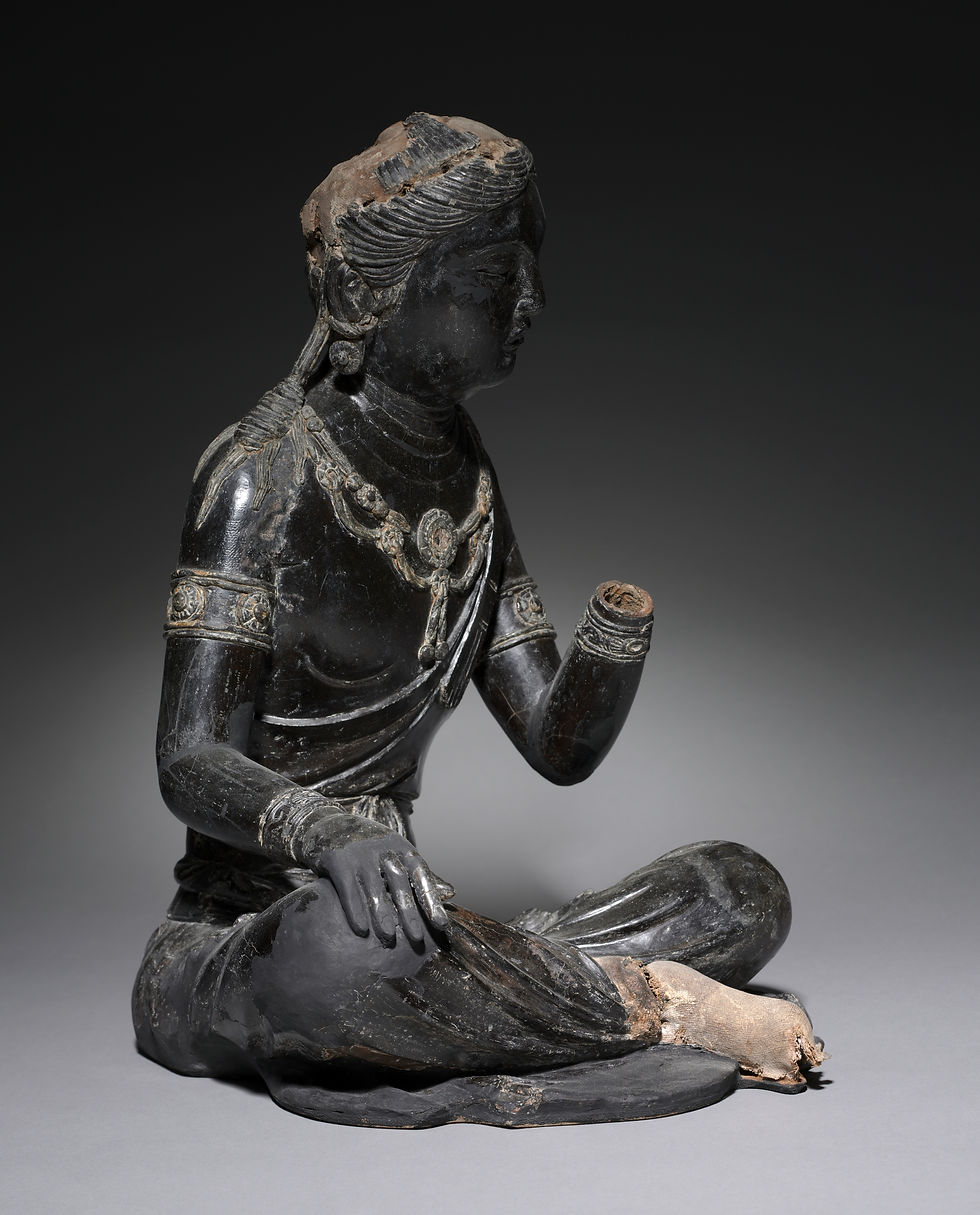唐代筆記 Vol.11 唐代菩薩:存世罕見的脫胎夾紵雕塑,埃斯肯納齊(Eskenazi)、盧芹齋(C.T.Loo)經手,克里夫蘭博物館所藏 - A Rare Tang Dynasty Heirloom Lacquer Bodhisattva, Giuseppe Eskenazi, C.T.Loo, Cleveland Museum of Art Collection.
- SACA

- Aug 16, 2024
- 4 min read
儘管漆器堅硬且不畏蟲蛀,但耐久性卻比不上木雕或石雕,因此這是現存罕見的唐代傑作。SACA學會曾發表關於存世唐代或以前的大漆佛的文章。
漆是一種了不起的材料,早在新石器時代就已在中國用作保護性覆蓋物。中國人很早便掌握了前文涉及的三尊佛陀生產中採用的多項技術,例如將漆與骨灰混合在一起,最早可以追溯到戰國時代(公元前475-221年),大漆技術被大量用在製作棺材,盒子和其他器皿上。就在這個時期,木胎夾紵(在漆和木材之間使用紵麻,添加骨頭、血液和其他物質)、脫胎夾紵工藝都已經出現。
脫胎夾紵工藝最早可追溯到公元前四世紀,這項高超的技藝顯然是專門為特殊、昂貴以及重要作品預留的。
Lacquer is a remarkable material that has been used as a protective covering in China since the Neolithic period. The Chinese were early masters of many of the techniques employed in the production of the three Buddhas covered earlier, such as the mixing of lacquer with ashes, dating back as far as the Warring States period (475-221 BC), when the technique of lacquer was used in great quantities in the production of coffins, boxes and other vessels.
It was during this time that lacquer (the use of lacquer between lacquer and wood, with the addition of bone, blood and other substances) and detreated lacquer were introduced.
SACA學會2020年發表:
“漆佛的秘密” 是弗利爾博物館2017-2018年的研究項目,展覽匯聚了已知僅存於西方的三件極為罕見6-7世紀真人尺寸中國雕塑:分別是沃爾特美術館、大都會博物館、弗利爾博物館的三件漆佛。 從文物美學角度,三尊漆佛的首次同時展出,帶來了有趣的平行對比;從科學角度, 使用專用設備和高科技檢測方法進行分析:從找出漆料來自哪種樹種,到漆層中摻入哪種添加物等,層層分析,充分展示了西方如何利用科學來幫助藝術理解和欣賞。 中西結合,科學與藝術的探索,又能給此類漆佛的帶來什麼樣有趣的新見解呢?
▲ 大漆菩薩,脫胎夾紵,唐代,克利夫蘭博物館藏 / Attendant bodhisattva; China, Tang dynasty (618–907), 8th century; Hollow-core lacquer; 45.6 cm (17.9 in); Cleveland Museum of Art, Given in memory of Parmelee Eels by his wife Amelia Chisolm Elms (1983.86)
菩薩是致力於眾生靈性覺醒的覺悟者,他以輕鬆的姿勢端坐,雙目半閉,表現出深邃的冥想。這尊佛像的造型非常感性。
它是使用乾漆技術製成,先以黏土製成核心,然後覆上塗滿漆料的布料。一旦漆層凝固,便會移除核心。這種空心乾漆造像重量輕,方便攜帶。
這件作品曾經遭受嚴重的表面修飾,扭曲了它原本的美感。經過博物館的修復工作,除去了過度塗漆和過度修復的外衣,露出了光亮的黑漆表面的真面目,並有琢金裝飾和顏料的痕跡。
圖片來源: Benjamin W. Yim
Bodhisattva 菩薩 700s
China, Tang dynasty (618-907)
Dry lacquer
Overall: 44 x 37 cm (17 5/16 x 14 9/16 in.)
Given in memory of Howard Parmelee Eells Jr. by his wife, Adele Chisholm Eells 1983.86
While lacquer is tough and impervious to insects, it is less durable than wooden or stone sculptures, so this is a rare surviving Tang example.
The bodhisattva, an enlightened being dedicated to the spiritual awakening of all beings, is shown sitting in a relaxed pose, the eyes half-closed in an expression of profound meditation. The statue is modeled in a sensuous manner.
It is made using the dry lacquer technique whereby a clay core is first constructed and then overlaid with fabrics saturated with lacquer. Once the lacquer layers are set, the core is removed. This kind of hollow dry lacquer statue is lightweight and easy to carry.
The piece once suffered from severe surface retouching that distorted its original beauty. The museum's conservation work has removed coats of overpainting and over-restoration, revealing the true appearance of the glossy black lacquered surface with traces of cut-gold decoration and pigments.
Provenance
by 1933–?
(C.T. Loo 盧芹齋 [1880–1957], Paris, France)
?–1983
The Mount Trust of Captain Vivian Francis [1891–1968] and Mrs. Cornelia Stuyvesant Vanderbilt Bulkeley-Johnson [1900–1976], Churchill, Oxfordshire, England
19 April 1983
(Christie's, London, England, 19 April 1983 sale, lot 42)
1983
(J. E. Eskenazi, Ltd., London, UK, sold to the Cleveland Museum of Art)
1983–
The Cleveland Museum of Art, Cleveland, OH
Exhibition History
Streams and Mountains Without End: Asian Art and the Legacy of Sherman E. Lee at the Cleveland Museum of Art. The Cleveland Museum of Art, Cleveland, OH (organizer) (June 27-August 23, 2009).
The Twain Shall Meet. The Cleveland Museum of Art, Cleveland, OH (organizer) (October 30, 1985-January 5, 1986).
The Year in Review for 1983. The Cleveland Museum of Art, Cleveland, OH (organizer) (February 22-April 8, 1984).
The Mount Trust Collection of Chinese Art. Victoria and Albert Museum, London, England (January-March 1970).
The Arts of the Sung Dynasty. Arts Council of Great Britain and the Oriental Ceramic Society, London, England (June 16–July 23, 1960).





























Comments